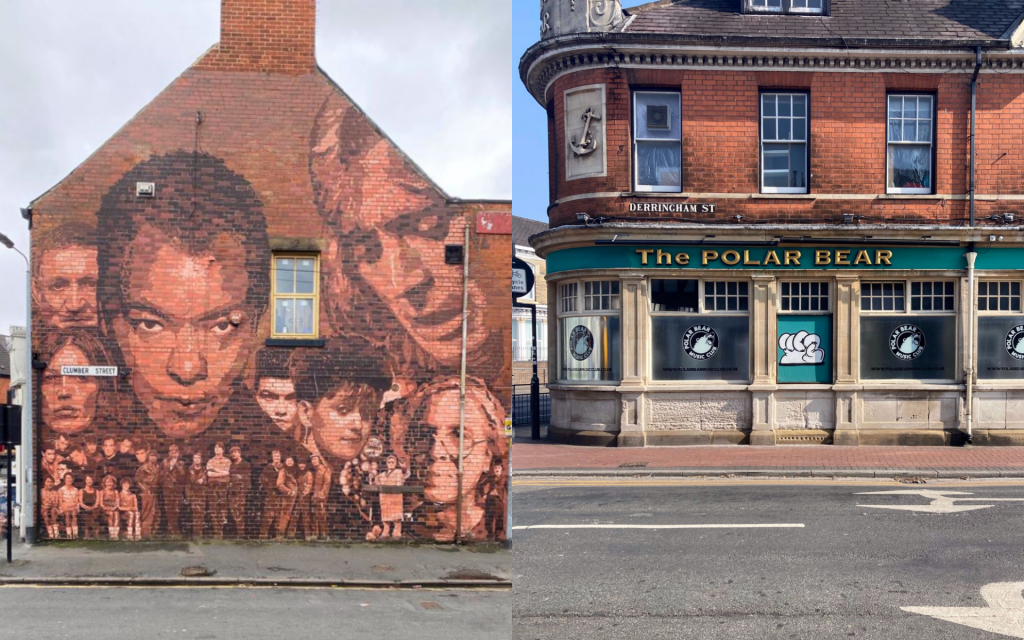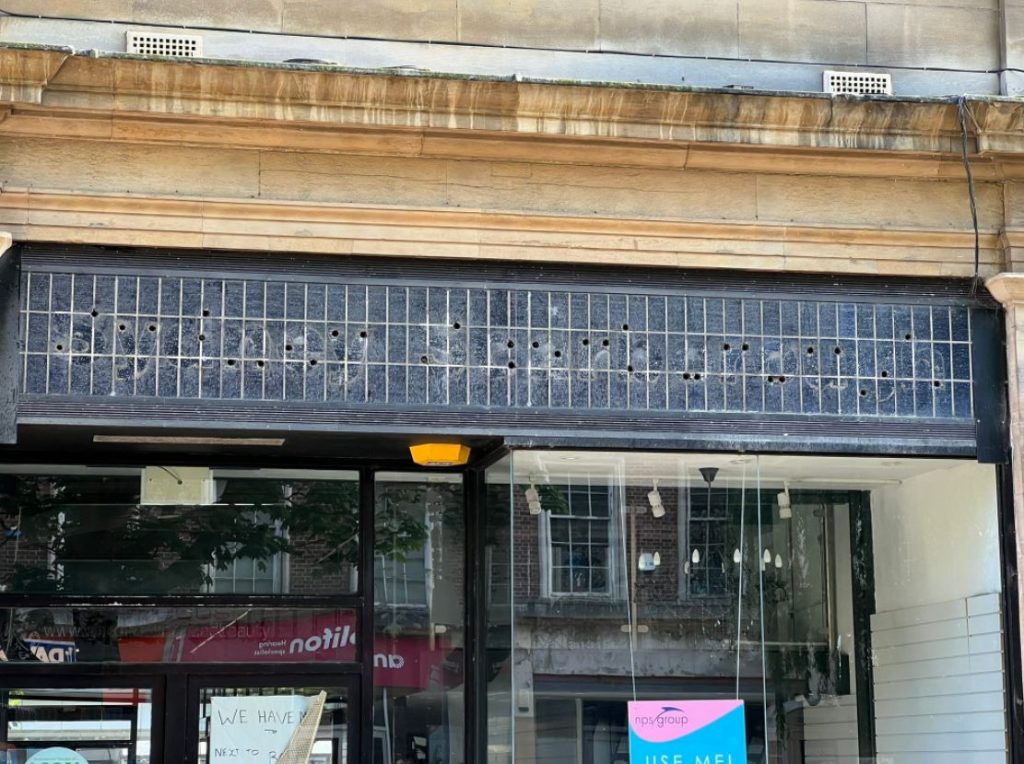
Ed Ullyart’s mural on Clumber Street, and The Polar Bear. Photos courtesy of Charlotte Tomlinson.
History and heritage are embedded in the built environment of cities in lots of ways. Through Blue Plaque Schemes, for instance, which celebrate and commemorate important people who came from that place or shaped it. Or through street names that give nods to places’ past lives, perhaps as friaries or marketplaces or icehouses. The architecture of buildings themselves offer an abundance of information (if you know where to look), written into the stylistic details or industrial features that remain, or the artistic flourishes that have since been added. On the corner of Clumber Street in Hull’s Avenues district, a new mural unveiled in 2021 plays tribute to the city’s music history. Painted by Ed Ullyart, the artwork includes images of various ‘Hull’ musicians, like Mick Ronson, Fine Young Cannibals, and The Watersons, as well as nods to former local residents and businesses. Heritage murals have become increasingly popular over the last few years in the city. But this one in particular reflects a thread in our research that has been cropping up again and again – that music plays an important part in the history of Hull and the way that people remember their lives here.
Music, of course, has a powerful relationship with memory. Listening to a particular song can take you back to a particular time and place, acting as a mental time machine that transports you to where you were, who you were with, and how you felt at a given time. It’s sometimes easier to remember the words to a favourite song than it is to recall particular dates or details from the past. The mnemonic power of music is such that it is commonly used in therapies for people with Dementia and Alzheimer’s, and music clearly has a special emotive power, meaning that it can evoke emotions about people and places that aren’t easily translated into words. And, because music is something we usually share with one another, it can help to communicate remembered experiences to others, and become a structure upon which people build their life narratives and tell their stories.
In our project so far, people have often told their stories of Hull’s music history through places. Nightlife venues, for example, like The Polar Bear and The Adelphi and City Hall, where they have attended gigs or danced with friends or perhaps even played music themselves. Or public spaces, transformed to host concerts and festivals, like for Sunday concerts in East Park in the 1960s or weekends of live music on Hull Marina for Humber Street Sesh. One element of Hull’s music history that people often tell us about is shopping in the city’s record stores in the 1950s and 1960s. In this quote, one of our interviewees explains the weekend ritual of going into town in search of a new vinyl, and which places were local favourites for building a record collection:
“One of the things that we used to like to do on a Saturday was to go into town on the bus, and go to one or other of the gramophone record shops as they were called in those days. The main ones for all of us, was either Sydney Scarborough, under the City Hall, or Gough and Davy’s in Saville Street. They had a good record department in the basement of Hammonds, in the late 50s. But these two I’ve just mentioned, they were the two, because they had a terrific stock of records, and the great thing was, particularly with Gough and Davy, because it was a bit bigger than Sydney Scarborough’s – Syd Scarborough’s was, you could go in at one end and come out the other, you could go in at Carr Lane and come out on South Street. With Gough and Davy’s, you’d go into the shop where they sold the pianos and the harps and violins upstairs, and you went down the stairs into the basement and that was where they sold the gramophone records. And it was lovely down there because you went down the staircase and straight ahead of you was the desk where the three or four assistants were, with the racks and records behind them. And you’d go take your list of whatever you wanted and they used to have catalogues, record catalogues on the desk if you hadn’t got a list and you could go sit in a chair and just pick out any one, see if they’d got it. Once you decided on what you wanted to hear, first, they’d give you, they wouldn’t allow you about 20 records and you’d sit there for the rest of the day there was none of that, but they’d let you have three or four and they’d say “Number Four Booth!” and there were little booths or rooms on each side of the staircase, with just a couple of chairs in and nothing else, and there was like a, a loud speaker, in the corner, and the girls behind the counter would put the record on, and if you liked it you could buy it, go and pay for it. So we used to spend quite a lot of our money and our time down there and it was great. And that was how record collections started in those days.”

Syd Scarborough’s ‘Ghost Sign’, photo courtesy of James Hoggarth.
As well as the venues and shops at the heart of Hull’s post-war music scene, our project participants often tell us about high-profile musical events that have happened in the city, most notably The Beatles’ visits to Hull in the early 1960s:
‘Age 12 I went with school friends to the ABC Cinema (which was on the spot where St Stephen’s Shopping Centre stands), we went to see The Beatles, it was 1964 and we screamed and screamed. I still have the ticket from the concert (and many more tickets from other concerts over the years).’
Interestingly, it seems that people don’t even need to have attended these high-profile events for them to have become an important part of how they narrate their lives and the story of the city:
‘And another little memory has just popped into my head, my friend Linda got to go see The Beatles at the ABC in 1963! I didn’t (laughs). They came to Hull, and my friend Linda got to go…I remember her telling me that she’d managed to get, she’d got tickets to go see The Beatles at the ABC. And of course in those days you wouldn’t hear anything because the girls just screamed and screamed and screamed, I mean, you’ve probably seen black and white photos of Beatles concerts.’
Other oral history interviewees have similarly described other ‘premiership division’ acts that came to Hull, including those they did see, and those they missed out on:
‘Going back to music, live music, the first band that I nearly saw was David Bowie, and that was in East Park, in the late 60s. Every Sunday, they used to have, in East Park there was a concert. And they had, you won’t have heard of any of the bands, people like The Amazing Blondel and they actually were, they’d made records a lot of them, and we had a local band called The Rats, you might have heard of them, in connection with Mick Ronson, he was the guitarist in The Rats at one point, so there was some, they weren’t just pub bands there was some quality stuff most Sundays, and especially in the summer obviously. And then, the other venues for music were, obviously Hull University, the Lawns in Cottingham and also on the main campus at Cottingham Road, there was somewhere called Brick House, Hull Brick House, it was a guy called Barry Nettleton who was a local promoter, so again we saw, I saw The Who in 1971 at the City Hall. So you’d called them Premiership division.’
These moments in music history were clearly very memorable for the people who have talked to us so far. But another reason people tell these stories, we think, is that talking about ‘legendary’ acts that have played in Hull communicates a sense of importance too. A city that hosts The Beatles is a city that matters, and so when people tell us about ‘big’ concerts (even ones that that they missed), they’re also telling us that Hull was important, that exciting things happened here. Moreover, because music is something communal and shared, it helps people to communicate a particular image of Hull that they know will be recognised and understood. And perhaps it also suggests a sense of community in this city, which means you don’t even need to have been at one of Hull’s ‘biggest gigs’ to claim a stake in it.
This also goes for instances in which people have used Hull’s music history to communicate other things about the city too. As well as talking about Hull’s importance, our interviewees have used music culture to reflect on the city’s character, pointing to themes including a sense of difference, a spirit of rebelliousness, and the importance of independence:
‘It wasn’t part of the London scene, or anything else, Hull’s sort of had its own way of dealing with things, which it always has done. It’s a mix of European influences and being isolated from the rest of the mainstream. I think it’s reflected culturally as well, like, the music. Hull, again, the music scene, fantastic music scene but it’s never been like Manchester or Liverpool or – cos it’s diverse, there’s loads going on. Like The Housemartins or somebody like that, I know they’re not technically from Hull but they all formed in Hull, and they brought out the greatest title ever which is London 0 – Hull 4, for an album. But they sort of fitted in with the Hull scene, cos they’re not, you can’t put them in any, they aren’t Punky or they aren’t New Wave or they aren’t, they just did their own thing.’
Earlier this month we appeared on BBC Radio Humberside to chat about Hull’s music history and the songs that mean something to people. We asked people to tell us about their own ‘Hull songs’ – whether they were favourites songs by bands ‘from Hull’, or genres and artists that they felt represented the city, or tunes that took them back to particular moments in Hull’s past. We were flooded with responses, which covered to-be-expected popular bands (The Beautiful South, Everything But The Girl) and rivalrous sporting anthems (Red Red Robin and Old Faithful), to more abstract or personal interpretations (Elbow’s Station Approach, which reminded someone of coming home to Paragon Station, was one of our favourites). If you’re quick, you’ll still be able to catch up through BBC iPlayer here.
At the end of the month, we’ll be pulling some of these ‘Hull songs’ into a public playlist and sharing it through our newsletter. We’ll include songs that have come up in our oral history interviews, songs that have been discussed in our workshops, and songs that are suggested to us through our social media accounts. So, if you’d like to get involved, please tell us – which songs, artists, genres, and music venues are important or memorable to you? And which do you think are most important to the story of post-war Hull?
Comments are closed.